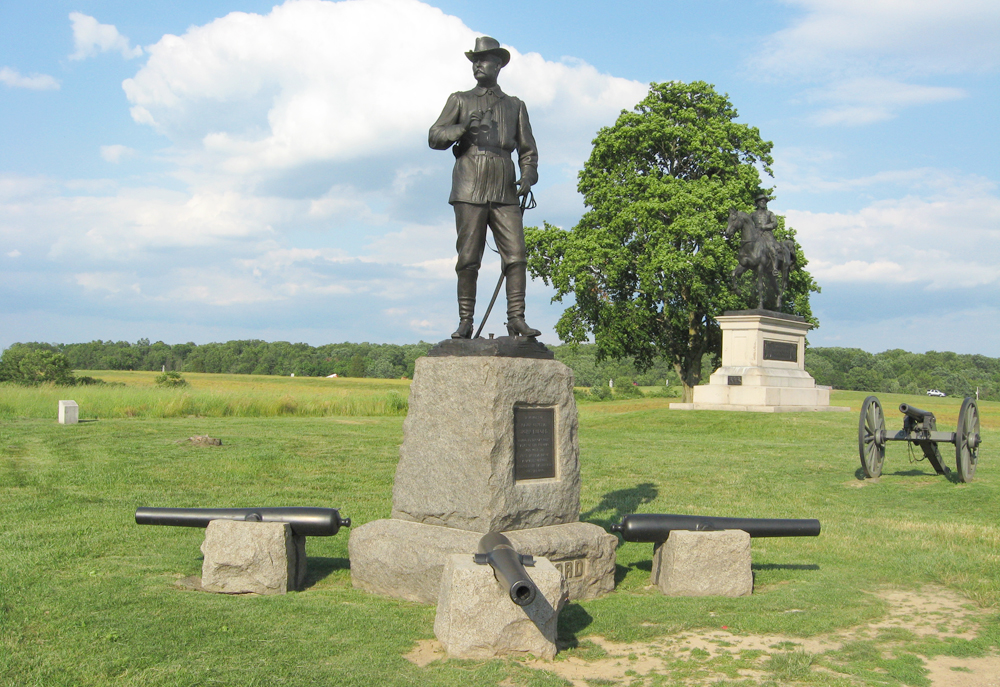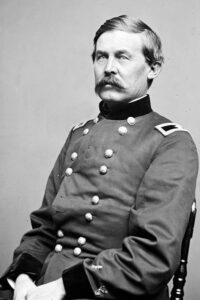
Battlefield Highlights: Where the Battle Began – Buford Holds The High Ground
May 30, 2023Have you ever wondered about the pivotal moments that shaped the outcome of the American Civil War? One such moment occurred on the first day of the Battle of Gettysburg.
General John Buford’s actions on that first day at Gettysburg were crucial in determining the final outcome of the battle. By holding the line against Confederate forces, he helped buy time for the Union army to reinforce its position, an action that ultimately determined the course of the entire conflict.
Who Was General Buford?
John Buford was born in Kentucky on March 4, 1826. He was the half-brother of Union General Napoleon B. Buford and the cousin of Confederate General Abraham Buford.
West Point trained and a veteran of the 2nd Dragoons, Buford recognized the importance of Gettysburg’s strategic position as a hub of several major roads. He expertly positioned his division to delay the Confederate forces advancing on the city until Union infantry could reach the field, allowing the Army of the Potomac to control the vital high ground south and east of town throughout the battle.
Sadly, Buford did not survive the year. He contracted typhoid during the autumn campaign on the Rappahannock, and he died on Dec. 16, 1863. A deathbed promotion to Major General was backdated to July 1, 1863, the date of his triumph at Gettysburg.
The Battle Begins
JULY 1, 1863 – 7:30 AM
The First Shot is Fired
The first shot of the Battle of Gettysburg is said to have been fired by a Union cavalry officer at 7:30 A.M. on July 1st, 1863, along the Chambersburg Turnpike three miles west of the town.
Buford’s two Union Cavalry Brigades had arrived in Gettysburg the day before. Early on the morning of July 1st they spotted multiple Confederate divisions approaching the town from the west via Chambersburg Pike. In an effort to protect the high ground, Buford hastily formed defensive lines along Herr Ridge, McPherson Ridge, and Seminary Ridge just west of Gettysburg. The open, gently sloping terrain where the armies first engaged was not the ground either side wanted to hold, but these initial positions determined where most of the fighting would take place this day.
General Buford intended for this defense to be merely a delaying action to keep the Confederate forces at bay until the Union infantry could reinforce and occupy the heights south of town.
Confederate Major General Henry Heath was the first to engage with Buford’s cavalry at 7:30 AM. Expecting minimal resistance, he sent two divisions under Brigadier General James J. Archer and Joseph R. Davis ahead to occupy the town, but they were surprised to find the way blocked and fiercely defended.
Heavy fighting ensued. General Buford was able to hold out for a few hours until he was reinforced by Brigadier General Lysander Cutler and Solomon Meredith under Major General John F. Reynold’s I Corps.
First Day Casualties
The Union Army is estimated to have had 18,000 troops involved in the fighting on the first day of the battle, during which time they suffered around 9,000 casualties. The Confederates greatly outnumbered them with close to 30,000 men involved, of which they lost almost 7,000. Though seldom measured on its own, the first day alone at Gettysburg easily ranks among the top twenty bloodiest battles of the Civil War, and statistically was one of the deadliest days of the entire war.
The Importance of Buford’s Actions on the First Day of the Battle of Gettysburg
Buford’s decision to hold a defensive line along Cemetery Hill proved to be a masterstroke. By utilizing the high ground and taking advantage of natural obstacles such as stone walls and fences, he created a formidable defensive position that repelled multiple Confederate assaults, inflicting heavy casualties on the enemy while stalling their advance.
Buford’s use of artillery played a crucial role in his successful defense, positioning cannons at key vantage points to provide concentrated fire against the oncoming Confederate force.
Buford’s impromptu defensive stand on the first day allowed Union forces under General Meade to choose the best positions and marshal and consolidate their forces in preparation for the intense fighting that lay ahead, helping to tip the scales in favor of the Union.
Visiting the Site
When visiting the historical monument that marks the Gettysburg site where Buford made his stand, you can immerse yourself in the rich history and experience firsthand the significance of this pivotal part of the battlefield. It commemorates the bravery of those who fought and fell nearby and marks a profound connection to this immensely important chapter in American history. By visiting this important battlefield monument, the echoes of Buford’s actions may inspire you to delve deeper into the remarkable story of the Battle of Gettysburg.
Location of the Monument
The monument to Union Brigadier General John Buford is west of Gettysburg on Chambersburg Road (U.S. 30) at its intersection with Stone Avenue. (39°50’16.6″N 77°15’05.9″W)
Visit Gettysburg in Person
Plan your next excursion with us! Our bus tours of the historic Gettysburg Battlefield are active and ready to show you the sites of the historical battleground. Reservations can be made by calling our toll-free number at 877-680-8687. You can also purchase bus tour tickets online. Tours depart from the Gettysburg Tour Center located at 777 Baltimore St., Suite 100.
